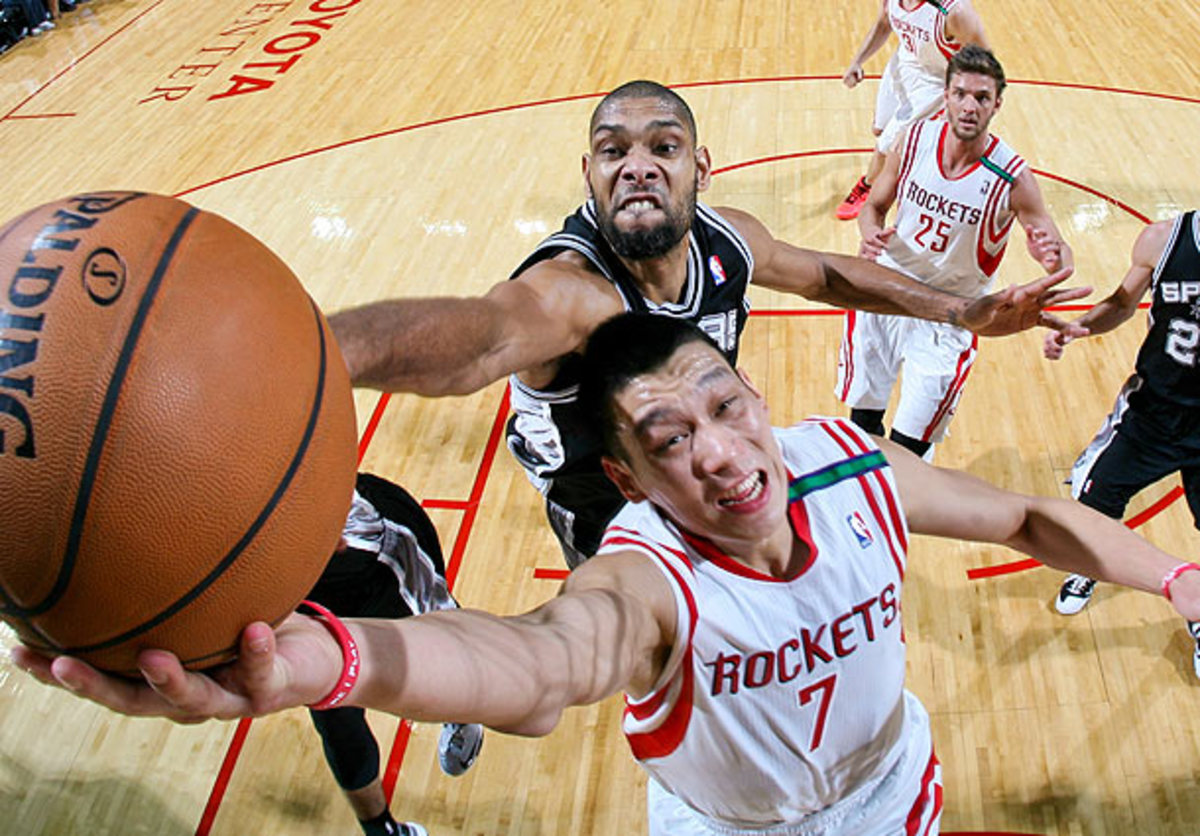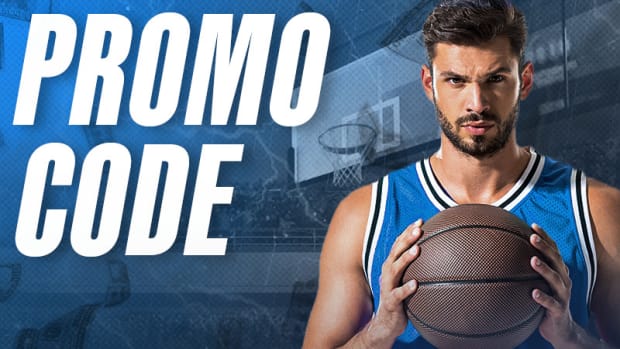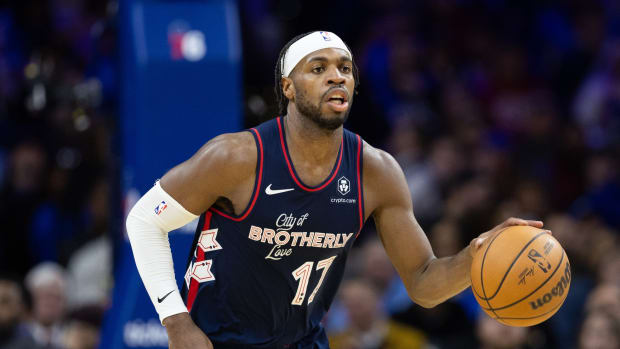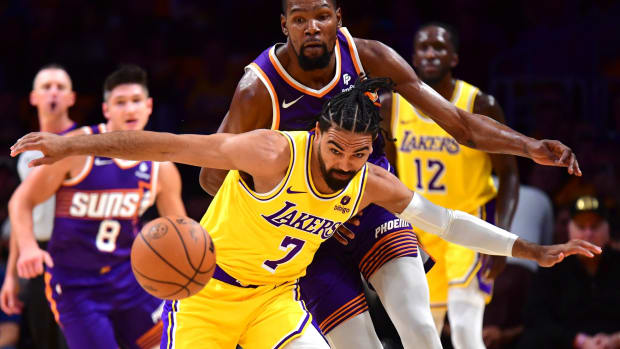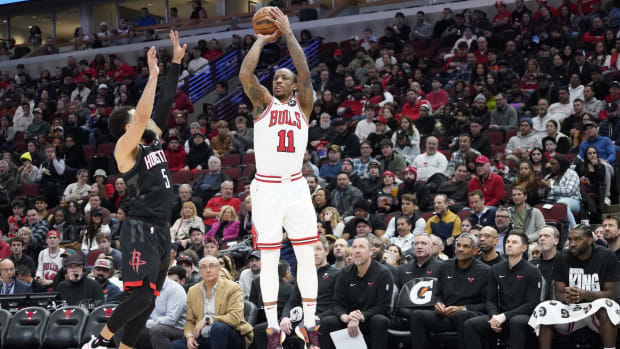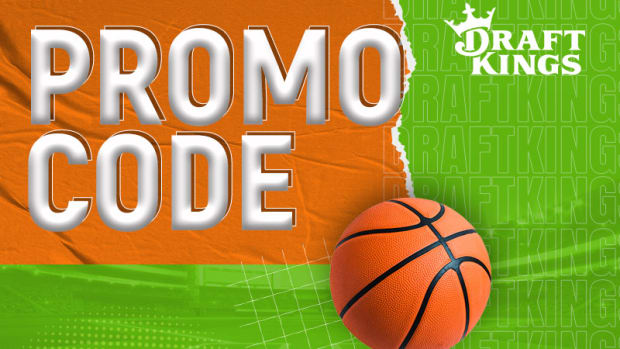The Fundamentals: Which improved defenses are here to stay?
Tim Duncan, 36, is averaging 2.5 blocks a game, his best mark since the 2006-07 season. (Layne Murdoch/NBAE via Getty Images)
By Rob Mahoney
Every NBA season has its mirages, whether due to lucky breaks, a fortunate schedule, uncharacteristically good shooting, or innumerable other factors. Part of the fun of an 82-game slate comes in discovering which improvements are more than mere trends. There's no fool-proof process, but the tape and data available do give the most curious of basketball fans a chance to interpret every bit of information available in an effort to assess the lay of the league.
Today we turn our attention -- and our magnifying glasses -- to three such trends, all of which feature stark improvements in team defense.
San Antonio Spurs (2012-13: 5th in defensive efficiency, 98.5 points allowed per 100 possessions; '11-12: 11th, 100.6 points allowed)
Though Gregg Popovich had been as proactive as possible in accounting for Tim Duncan's inevitable decline, even his best efforts couldn't completely offset the half-step lost and the lift that had vanished. Last year, Duncan was still effective and unquestionably cerebral, but the toll of a long career seemed to take away the very crux of his -- and by extension, the Spurs' -- defensive transcendence.
But this season a funny thing happened on the way to the Hall of Fame: Duncan not only has rejuvenated his scoring and rebounding marks to prime-levels, but appears completely capable of again anchoring a team defense rather than merely participating in one. The Spurs' most pressing needs (another rebounder here, another interior defender there) of the last few seasons were all created by Duncan's drop-off, but in reversing the hands of time Duncan offers a new world of possibility to a Spurs team that assumed his downward turn as fact.
Players like Tiago Splitter and Boris Diaw were once defined by the negative space in their defensive games. But with Duncan more closely resembling his best basketball self, Splitter and Diaw's defense can now be appreciated in very different (and far more reasonable) context. Splitter, in particular, bore the initial burden of a long-awaited arrival and long-brewing expectations, but a little NBA seasoning has made him an integral part to San Antonio's most successful defensive lineups.We saw shades of that defensive impact a season ago, but the Spurs had trouble maintaining their atom-splitting offensive precision whenever Duncan and Splitter were on the floor together. A little clutter clearly goes a long way, and though Duncan and Splitter were each a part of explosive offensive lineups individually, their combination together yielded an offense that scored about nine points fewer per 100 possessions than the Spurs' season average. That's what ultimately made Diaw such a terrific late-season find; with decent, girth-defying defense and the capacity to reroute offensive possessions by way of his handle and passing, Diaw represented a happy medium between Splitter and floor-spacer extraordinaire Matt Bonner. With Duncan reinvigorated, his offensive chemistry with Splitter has improved significantly, the need for Bonner has dwindled and the grounds for playing better defensive bigs has only increased.
The Spurs attempted, in recent years, to shift the workload away from Duncan as a matter of courtesy. He hardly seemed capable of being the superstar-level big he once was, and with more able-bodied stars at his side, it only seemed appropriate to shift the burdens of San Antonio's play to the Tony Parker or Manu Ginobili. Yet in this wind-back-the-clock season, Duncan has undone that redistribution of responsibility; this team will now go as far as he can take them with his defense, and we know full well what he can do as the core piece of a capable defensive team. At present, all the pieces fit, though only because Duncan gives new meaning and power to their arrangement. He empowers Kawhi Leonard, who continues to ace every defensive test in his sophomore season, and Danny Green, who has become a pesky on-ball foil. He makes up for Parker's miscalculations, Ginobili's gambles and whatever it is that Gary Neal is doing defensively. He bridges the best available lineup options, aids starters and reserves alike, and gives the Spurs a real (if completely overlooked) shot at upsetting the playoff balance.
All of which results in a team that ranked 15th in effective field goal percentage allowed a season ago leaping up to 4th in that same measure -- all because Duncan found his youth wedged between the cushions of his couch over the summer. We don't really have any way of knowing how long Duncan's renewal might last; let's just hope it endures the length of what could be a fascinating postseason run.
Dante Cunningham has been a pleasant defensive surprise for the Wolves. (David Sherman/NBAE via Getty Images)
Minnesota Timberwolves ('12-13: 7th, 100.2 points allowed per 100; '11-12: 20th, 103.6 points allowed)
For a team so often cited as a League Pass favorite, the Wolves play a shockingly inaccessible style of basketball. NBA die-hards will still find their fill of smart basketball and eccentric individual styles, but Kevin Love's oscillation between inefficiency and injury coupled with Ricky Rubio's very gradual return to form has robbed this team of some of its deserved charm. Minnesota's offense often gets ugly: No team in the league shoots threes at a lesser clip, and the Wolves -- by necessity more than stylistic choice -- have earned most of their wins by muddling games and better navigating the messy aftermath. Defense has been the order of Minnesota's season, and remains the biggest reason why the Wolves remain a .500 team in spite of their consistently miserable injury luck.
All of which brings us to a problematic word, if only because of the stigma attached to it: overachievement. This is a team making do with an upturned roster and winning the best way they can under the circumstances. That's admirable as hell, and I've found myself drawn to this team's particular resilience. But none of that changes the fact that the Wolves, smart and focused though they may be, simply don't seem to have the personnel necessary to uphold an elite defense over the course of a full season. They're an elite rebounding team and are deft at avoiding contact when necessary, but in their current form they lack the particular bundle of skills necessary to play a complete defensive game. There are still plenty of player absences and miscellaneous factors to suss out before we can declaratively say where Minnesota will fall, but we've already seen the Wolves slide a bit defensively over their last 15 games and can likely pencil them in for a quality (but sub-elite) defensive standing.
Nothing in the NBA is more important than process, and it's in that regard that this well-coached, hard-working squad has a very clear leg up. Yet there comes a point where the payoffs of that process cannot totally overcome the deficiencies of the roster, specifically as they relate to defensive coverage. Knowing where to be defensively only matters if a team is athletic enough to actually beat its opponents to specific spots, and throughout the Wolves' roster we see concessions in speed and length -- the exact factors that allow informed defensive teams to execute the full mandates of their respective systems. For the first 15 games of the season, Minnesota didn't encounter many problems in that regard; they ranked 6th in the league in effective field goal percentage allowed, and did a particularly good job in limiting opponents to 57.3 percent shooting in the restricted area.
Andrei Kirilenko's pervasive defense deserves plenty of credit, as does the technical improvement of Nikola Pekovic. The Wolves' hulk of a center still may not be the most agile, and in a way seems anachronistic given the evolution of his position. Yet Pek has done well in meeting pick-and-roll ball-handlers without conceding passing lanes to the roll man, and recovers well enough to be a plus defender overall. Still, his lack of traditional athleticism comes into play when combined with that lack in the Wolves' perimeter players.
Rubio is the great unknown in all of this, as the game-changing guard doesn't yet have access to his full defensive range. Last season we saw shades of Jason Kidd-style savvy in Rubio's defense, allowing him to balance his assigned mark with a slight hedge into passing and driving lanes, and his ability as a pickpocket is noteworthy in its own right. Provided that he can mimic his impact of a season ago with this new roster and a repaired ACL, Rubio's value to the entirety of the defense is really significant. I wouldn't dare count him out, but there's a lot that remains to be seen with regard to what Rubio's capable of this season.
In the meantime, losing Kevin Love might actually help the Wolves' D, if only because of the minutes and role afforded to defensive specialist Dante Cunningham. Love is actually a better defender than he's often credited as, but Cunningham has done really outstanding (and slightly unexpected) defensive work during Love's various absences; together with Kirilenko, Pekovic, Luke Ridnour and Alexey Shved, Cunningham has keyed an often-used lineup that allows just 95.3 points per 100 possessions on average. That that group is barely better than that mark offensively speaks to their current quandary, and some of the more general problems that arise when Love and Rubio aren't at their best.
There's no shame in being merely a top-10 defense, and yet it might seem tempting to dub Minnesota's statistical slips on that end as some kind of regression. The Wolves certainly aren't beyond botching elements of their scheme at times or failing to execute at others, but for the most part, this is simply a good defensive team that had a stint as a great one before settling in for the long haul.
Blake Griffin and DeAndre Jordan have been instrumental in the Clippers' defensive turnaround. (Andrew D. Bernstein/NBAE via Getty Images)
Los Angeles Clippers ('12-13: 3rd, 98 points allowed per 100; '11-12: 18th, 102.9 points allowed)
The most pronounced defensive improvement in the league comes courtesy of one of the hottest teams in the NBA -- and a newly minted title contender. The Clippers will undoubtedly cool, but for the moment I'm inclined to buy into the very real improvement that shot L.A. up the defensive rankings without any dramatic overhaul to its underlying system.
That in itself is somewhat miraculous, especially considering the wealth of (richly deserved) criticism hurled at head coach Vinny Del Negro. There's no doubt that a more clever coach could do more with this current roster, but the simplicity of Del Negro's sets and defensive principles have allowed talented players to make plenty of their individual abilities. That's where Blake Griffin and DeAndre Jordan, big men who are establishing the roots of a long-term defensive chemistry, stand front and center. One can learn a lot about a defense by examining how both bigs play off of one another, and though both Griffin and Jordan are works in progress, they're starting to work better in communion and have dramatically improved their positioning overall. Both top-tier athletes have also been allowed -- as noted by ESPN.com's Kevin Arnovitz -- to use their speed to better advantage, an evolution that is naturally linked to their joint ability to recover on the back line.
Blitzing a ball-handler is an attractive option, but it only makes sense if the rest of the defense is capable of correcting a potential mistake. Griffin and Jordan still aren't yet great in that regard, but they're far better than they were a year ago. That's crucial in itself, but even more so when we consider the impact relative to a handsy guard like Chris Paul; the Clippers' lead guard picks off ball-handlers better than any player in the league, but he can't help but apply pressure on the perimeter -- even if it means putting a driving lane at risk. Last year, that occasionally resulted in an open layup by way of a late rotation or lack of communication. But this season, Griffin and Jordan are responsible (and generous) enough to compensate for the cost of Paul doing business and can better anticipate his gambles.
Yet we shouldn't gloss over the importance of personnel changes, as evidenced by the substantial defensive advantage created by the Clippers' second unit. Jamal Crawford may not be much of a defensive factor, but Eric Bledsoe is a tremendous ball hawk, Lamar Odom looks to have returned to form after his paid 2011-12 vacation and Matt Barnes and Ronny Turiaf round out the lineup as sensible team defenders who make the right reads. Together, they comprise the best second unit in the NBA, and a reserve group far more complete than anything L.A. brought off the bench last season. The offensive workings of the Clipper subs are fascinating in their own right, but it's that unit's defense against overwhelmed opponents that generates a very real and substantial advantage.
Unfortunately, some of that edge will undoubtedly be mitigated in a potential playoff series, as rotations shorten for both the Clippers and their opponents. That's where Del Negro will ultimately be put to the test, with both lineups and egos to consider. The Clippers are incredibly deep, and though that will prove to be an invaluable asset during the regular season, the payoff in the postseason will require more precise maneuvering on Del Negro's part.
But for now, L.A. gets to have its cake and eat it, too, as improvements from top to bottom set up the Clips for a long playoff run provided that disorganization and simplicity don't get in the way of a good thing.
GO FIGURE
A look at some of the relevant quantitative trends and tidbits emerging around the league.
Carmelo Anthony is boasting a career-best turnover rate for the Knicks. (Fernando Medina/NBAE via Getty Images)
• Rebounding from the guard spots can be both a blessing and a curse, as overly aggressive backcourt players can pick up unnecessary fouls or compromise transition defense in their efforts. Nevertheless, there's an obvious value in perimeter players who can make up for a lack of rebounding inside, and an aesthetic reward in seeing out-of-position players streak in for a bonus rebound. Eric Bledsoe (who grabs an offensive board on 7 percent of his team's misses) and Russell Westbrook (5.1 percent) are among the most successful guards in snatching up stray rebounds, but leading all nominal guards in offensive rebounding percentage is 19-year-old Magic rookie Moe Harkless -- the mostly-small-forward whom Jacque Vaughn recently parked on the bench with a pair of DNP-CDs.
• At present, James Harden is averaging 10.3 free throw attempts per game. Only five active players have ever reached that mark: Dwight Howard (four times), Dwyane Wade (twice), LeBron James (twice), Kevin Martin and Paul Pierce.
• Carmelo Anthony has never been particularly turnover prone, in part because he so often ended his team's ball movement on the catch. For both the Nuggets and Knicks, Anthony saw himself as an offensive endpoint, and played as though there were no superior option to his contested mid-range jumper. This season has been decidedly different, and though Anthony actually averaged significantly more assists last year, his participation within the Knicks' offense has been altogether more committed. He now operates with the understanding that he doesn't have to make a play with every touch, and as a result Melo is posting a career-best turnover rate despite also registering a career-high usage rate. He's shooting a ton, playing within the rules of the offense and thriving in almost every statistical dimension.
NOTES FROM AROUND THE ASSOCIATION
1. Tyrus Thomas lives!
Good news for people who like idling potential: Tyrus Thomas is back in the lineup for the Bobcats. Uneven play has made Thomas seem like an old NBA soul, but he's actually only 26 years old and still could play a role in Charlotte's rebuilding plans. With Mike Dunlap striving for accountability, it may not be optimal to have to account for a player as maddening as Thomas, but the three years and $26 million remaining on his contract may render that preference irrelevant. As such, we can fully expect the Bobcats and Thomas to try to make things work. It's highly unlikely that Thomas will live up to either his contract value or public expectations of his game, but I could easily see him finding a sort of peaceful productivity for a Bobcats team trying to fit the foundation of a roster together.
2. Mark Jackson's curious timeout usage
There's no question that Warriors head coach Mark Jackson is having an outstanding season as both a motivator and defensive architect, but I still can't quite understand his timeout usage. Maybe the problem is that the Warriors are so consistently committed to pushing the break, but it seems as though Jackson often undercuts opportunities for advantage in transition in an effort to correct some mistake or cut off an opponent's momentum. As much as I appreciate the attention to detail, it does seem like Jackson could do more good by letting his team -- young and mistake-prone they may be at times -- run the course of those sequences.
3. Dirk and Amar'e's phenomenal usage of "phenomenal"
Two players of different teams and different worlds, who seem to love the word "phenomenal." No Dirk Nowitzki postgame scrum goes without it, and rare is the Amar'e Stoudemire interview without some "phenomenal" drop. But the interesting thing (and the low-hanging fruit for comedians and armchair psychologists alike): Nowitzki uses the word specifically to describe teammates and opponents, whereas Stoudemire's most common usage might be in categorizing his own post-recovery abilities. We all have our pet descriptors and verbal crutches, but I always get a kick out of two players with completely different personalities but oddly similar diction.
Mario Chalmers' development has further aided a strong Heat post game. (Issac Baldizon/NBAE via Getty Images)
4. Learning to work the post, featuring Mario Chalmers
Any team that makes a concentrated effort to work through the post creates a team-wide learning curve, beginning with the post-up man himself, and extending through cutters, shooters and passers. That's one reason why Miami's post offense keeps getting more and more sophisticated; not only is LeBron James expanding his repertoire of moves and fakes, but a player like Mario Chalmers is getting much better with his entry feeds and his play off the post in general. Many NBA guards will rush their passes into the post-up player, and in the process either commit a turnover or catch their teammate before they have a chance to establish position. But Chalmers has grown to be a really patient entry point into Miami's post offense, where he makes a concerted effort to post and re-post James as necessary before making his ensuing cut to clear out room. It's such a little thing, but that deliberate setup can make all the difference in a post-up possession.
5. Rudy Gay's separation of form and function
Basketball fans the world over obsess over shooting form, whether as a legitimate measure of a player's shooting ability or for the cheap thrill of seeing Shawn Marion's fling in action. Yet Rudy Gay has an interesting place in that conversation as one of the league's more idyllic shooters as far as form, and yet a merely average one in terms of performance. Gay's turnaround jumper is one of the smoothest releases in the league, to the point that his entire process undersells the difficulty of the timing and balance involved. Even for a professional, a fading shot after a 180-degree spin shouldn't look so consistently smooth, yet for Gay such finesse comes naturally. He's put in work on his shot, but there's a certain grace to his game that can't be earned in a gym. Yet in spite of it all, some unseen bit of Gay's release translates to 41-percent shooting overall and 32-percent shooting from three-point range. Shot selection is obviously an issue, but with an optimal release point and a hitch-free form, why isn't Gay a better shooter overall -- especially on uncontested tries?
6. Tristan Thompson, thriving in Anderson Varejao's absence
The Cavaliers are as bad a team as ever, but at least one person in Cleveland is benefitting from Anderson Varejao's knee contusion-induced absence. Twenty-one-year-old big man Tristan Thompson has averaged 12.9 points (on 51 percent shooting!) and 12.5 rebounds per game over his last 10, and though Cleveland has won just three of those games (two of which came against the mighty Wizards and Bobcats), this could be a sign that something is clicking for the former No. 4 overall pick. Many have given up on Thompson far too quickly, but we shouldn't let Kyrie Irving's meteoric rise rush a lesser prospect's development; he may never be a star, but Thompson has a promising career ahead of him as both a defender and an improved finisher.
7. Andris Biedrins, living large
It's apparently become something of a tradition to check in on Andris Biedrins in this space, but I thought his post defense against Blake Griffin and the Clippers deserved specific mention. The Warriors have largely opted to hide David Lee on DeAndre Jordan in their matchups with the Clips, thus relying on Biedrins, Festus Ezeli and Carl Landry to hold Griffin. Neither is a perfect solution, but Biedrins did a great job of holding his ground against the much stronger Griffin in the post, and even swatted a few of his attempts away. Biedrins is by no means a great interior defender, but going up against him is a bit like trying to play on a playground hoop that stands next to an overgrown tree.
8. The wane of Eric Maynor
There was a time not so long ago when the return of Eric Maynor was considered a legitimate boon for the Thunder, and a point of potential improvement over last season's back-up point guard crop. There was also a time not long before that when a ruckus was made for Maynor to be made a starter at Russell Westbrook's expense, if only by the most brash of playoff reactionaries. Nevertheless, it's striking how quickly Maynor -- who is soon to be a restricted free agent -- has slid into limited minutes for the Thunder. The growth of Reggie Jackson and the broadening of Kevin Durant's game have seemingly erased all need for Maynor's services, to the point where OKC has already weaned itself completely off of his rotational value. That may have been an easier call than expected given that Maynor is playing the worst basketball of his career, but his irrelevance is still a bit unexpected.
Statistical support for this post provided by NBA.com.






























